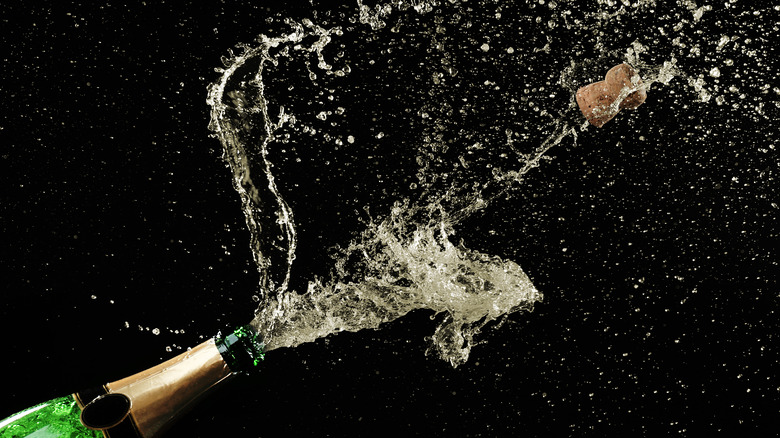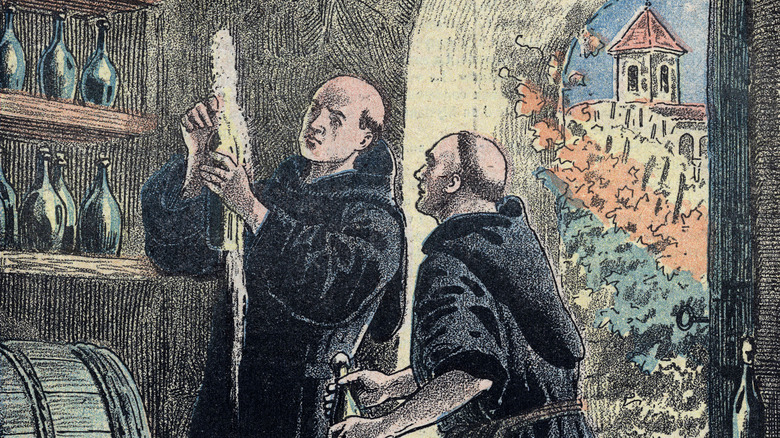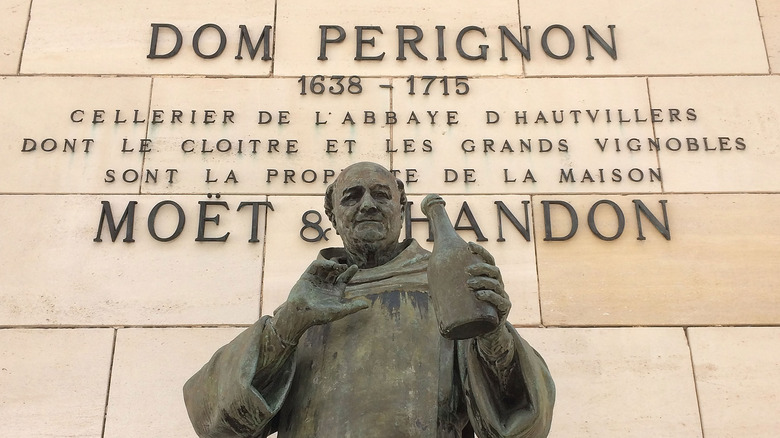How The Real Dom Pérignon Stopped Champagne From Exploding
While it may be fun and festive today, popping champagne bottles were not always a cause for celebration. Back in the 17th and 18th centuries, the bubbles were seen as a flaw and the wine could be a liability in the cellar. Inconsistent temperatures between seasons meant fermentation could resume while the wine was in the bottle, meaning corks could shoot out and start a chain reaction of popped bottles and broken glass. Dom Pérignon, a Benedictine monk, began using thicker glass and secured the corks with rope, a practice that led to the wire cages you can find on bubbly bottles today.
The goal, originally, was to keep the wine from becoming effervescent in the first place, so the monk worked at creating a superior still wine. Dom Pérignon had an outsized influence on the production methods, with a special focus on high-quality fruit. His dedication to hand-picking grapes, slow-pressing them, and meticulously blending wine was so integral to the craft that his name has been associated with Champagne for centuries.
Monk, winemaker, and innovator
Likely born around 1638, Dom Pérignon joined the Benedictine Order when he was 19. At age 28, he became cellar master at the Abbey of Saint-Pierre d'Hautvillers, now considered the birthplace of champagne, and held that title until his passing in 1715. During his lifetime, the wines produced by the monks were not intended to be sparkling, and the secondary fermentation inside the bottle that resulted in "perlage" (aka strings of bubbles) led to the wine being discarded. The cool winters of the Champagne region kept the yeast dormant, but once a warm spring arrived, fermentation would resume and the wines would become possessed with pesky little bubbles.
Today, secondary fermentation is a closely monitored process employed by the finest winemakers in the world to create delicate, pleasant bubbles in sparkling wine. But in the 17th century, to avoid catastrophe in the cellars come spring, Pérignon sought to avoid this inconsistent and inconvenient fizz. The cellar master used Spanish corks rather than the traditional wooden stoppers and secured them using hemp rope. He also sourced thicker, sturdier glass for the bottles to avoid breakage and keep the bottles from bursting.
Thinking outside the bottle
Many of the winemaking techniques pioneered by Pérignon involve the steps of production that take place before the wine even sees the inside of a bottle. His dedication to quality fruit and slow pressing resulted in a superior finished product, and the slow-pressing method he championed is still used in champagne production today. Rather than use whatever grapes were available for a given season, Dom Pérignon chose to evaluate the fruit for his blends through blind tastings, only selecting those that would lend superior qualities to the finished product.
When he passed, the cellars of the Abbey were filled with red and white wines ready for blending, but there was not a bubble to be found. It wasn't until 1927 that the Moët & Chandon wine company put his name on their now-infamous champagne, paying homage to his contributions to the art of winemaking. While Pérignon himself never purposefully made a bottle of bubbly, his dedication to the process and the craft of champagne earned him a place in vintner history. That, and of course, his anti-bottle-popping technology.



